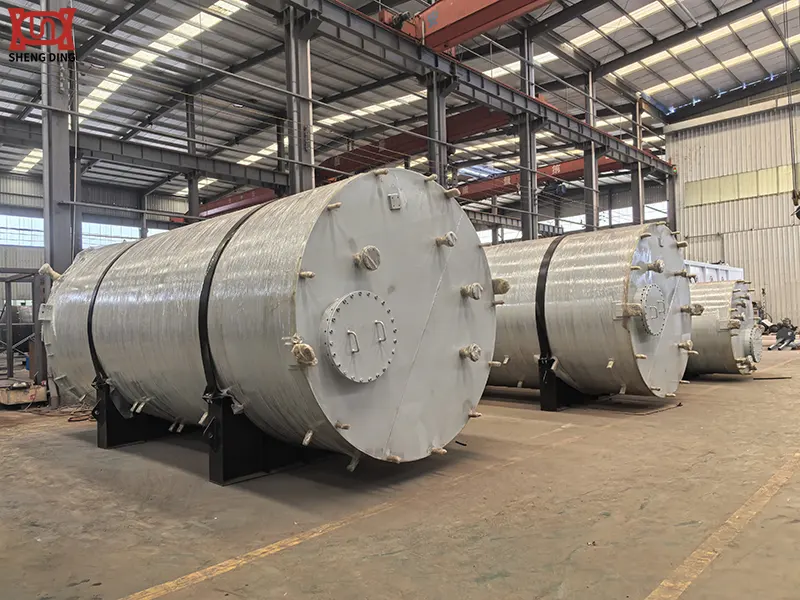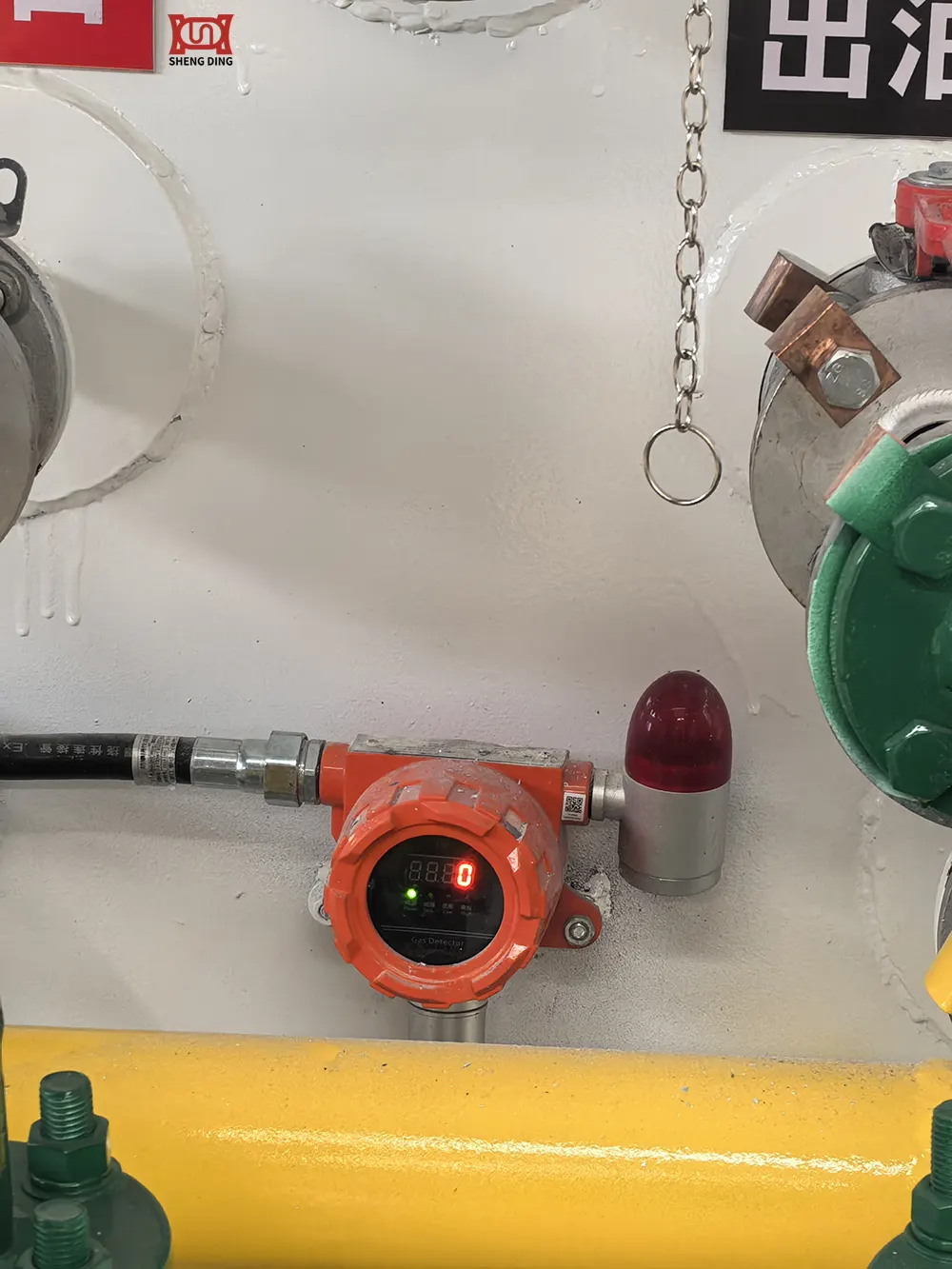How intelligent monitoring systems reshape the safety of skid-mounted fuel stations
As modular, mobile refueling facilities, skid-mounted fuel stations are widely used in logistics parks, construction sites, mining areas, and other locations. However, their compact layout, frequent mobility (in some scenarios), and the inherent risks of oil and gas storage present significant challenges in safety management, including concentrated risk points, numerous blind spots in manual inspections, and delayed emergency response. The intelligent monitoring system, leveraging the technical logic of "full-area coverage at the perception layer, intelligent analysis at the data layer, and coordinated response at the application layer," shifts from a "passive defense" approach to "active early warning and in-process intervention," comprehensively reshaping the safety of skid-mounted fuel stations.
To understand this "reshaping," it's important to first identify the core safety risks of skid-mounted fuel stations: fires and explosions caused by oil and gas leaks, equipment failures (tank corrosion, dispensing machine malfunctions), human misconduct (carrying ignition sources, operating outside of standard procedures), and environmental risks (high temperatures, lightning strikes, and transport collisions). The intelligent monitoring system addresses these risks, upgrading safety defenses through a closed loop of "precise perception, intelligent analysis, and coordinated response."


1. Perception Layer: From "Fixed-Point Scheduled Inspections" to "Full-Area Real-Time Monitoring," Eliminating Safety Blind Spots
Traditional skid-mounted fuel station safety monitoring relies on "manual scheduled inspections," which suffer from limited coverage, high missed detection rates, and an inability to capture transient risks (such as sudden oil and gas leaks) in real time. The intelligent monitoring system utilizes multi-dimensional sensors and intelligent vision devices to build a comprehensive, all-time perception network, accurately capturing risk signals:
| Monitoring Dimensions | Traditional Methods | Intelligent Monitoring Solution | Core Value |
| Oil and Gas Leak Detection | Fixed-Point Inspection with Portable Detectors | Deployment of catalytic combustion/infrared oil and gas sensors (installed on tank tops, dispenser ports, and pipeline connections) to collect real-time oil and gas concentration data and trigger immediate alarms when thresholds are exceeded. | Capturing "micro-leaks" (ppm level) to avoid cumulative risk |
| Open flame/smoke monitoring | Reliance on manual observation | High-definition cameras equipped with AI video analysis algorithms identify "open flames, smoke, and illegal smoking" in real time, eliminating interference from sunlight reflections and vehicle lights, with a false alarm rate of less than 0.1%. | Identifying ignition sources in seconds to prevent fires |
| Equipment status monitoring | Regular disassembly and inspection (high downtime costs) | 1. Storage tanks: Install pressure/liquid level sensors to monitor overpressure and over-liquid level (to prevent oil leakage); 2. Fuel dispensers: Connect current/voltage sensors to detect abnormal motor overload; 3. Transportation scenarios: Install vibration/shock sensors to monitor equipment displacement and collisions during transportation. |
Detect equipment failures early to avoid "operation with defects" |
| Personnel Behavior Monitoring | Manual On-site Supervision | 1. Smart Access Control + Facial Recognition: Only authorized personnel (certified operators) can enter the work area, and unauthorized intrusion will trigger an immediate alarm. 2. AI Visual Recognition: Real-time detection of behaviors such as "not wearing anti-static clothing, carrying lighters/mobile phones, and illegally disassembling equipment," with on-site audio and visual alerts and back-end push notifications. |
Reduce Human Operation Risks |
| Environmental Risk Monitoring | Rely on Weather Forecasts | Deploy temperature and humidity sensors, lightning strike counters, and wind speed sensors to automatically trigger "disconnection of non-essential power supplies and activation of ventilation equipment" in the event of high temperatures ( > 38oC) or impending lightning strikes. | Addressing Extreme Environmental Risks |
2. Data Layer: From "Manual Judgment" to "AI Intelligent Judgment" to Improve Risk Identification Accuracy
Traditional safety management relies on manual judgment to determine whether action is necessary, even when an anomaly is detected (such as slightly elevated oil and gas concentrations). This can easily lead to misjudgments (overreaction) or omissions (delayed action). The intelligent monitoring system utilizes edge computing combined with cloud-based big data analysis to achieve precise risk stratification and false alarm filtering:
2.1. Real-time Data Processing (Edge Computing):
Data collected by sensors, such as oil and gas concentration, equipment pressure, and video footage, is pre-processed on the local edge gateway. For example, this pre-processing filters out transient sensor fluctuations (such as sudden spikes and drops in concentration caused by wind). Only data indicating persistently exceeding standards or clear anomalies (such as the presence of open flames in video) is uploaded to the cloud, minimizing warning delays caused by data spikes.
2.2. In-depth AI Algorithm Analysis:
An AI model trained on historical safety data (such as leak cases and equipment failure records) enables "risk-based early warning":
- Level 1 Warning (Low Risk): If the oil and gas concentration slightly exceeds a threshold (e.g., 10% LEL), the system automatically activates ventilation equipment without manual intervention.
- Level 2 Warning (Medium Risk): If the concentration continues to rise (e.g., 30% LEL), the system sends an alert to the administrator's mobile phone and locks the fuel dispenser (prohibiting refueling operations).
- Level 3 Warning (High Risk): If the concentration approaches the lower explosion limit (e.g., 50% LEL) or an open flame is detected, the system immediately triggers fully automated measures, including shutting off the tank valve, activating the dry powder fire extinguishing device, and activating the fire alarm system.
2.3. Real-Time "Patrol Monitoring"
- Fire Equipment Status Identification: Automatically identifies whether a fire extinguisher has been misused, is correctly positioned, and whether the pressure gauge is within the normal range.
- Vehicle Guidance and Parking Compliance Detection: Automatically identifies whether vehicles are parked within designated marked areas and issues voice notifications for improper parking to prevent lane congestion.
- Dashboard Reading Recognition: Automatically identifies and records key instruments such as pressure gauges and level gauges, replacing manual meter readings. Threshold-exceeding alarms can also be set.
For example, a skid-mounted station in a logistics park experienced a minor leak due to a loose pipe joint. The AI system, through "concentration trend analysis" (rising from 5% LEL to 25% LEL within 5 minutes), issued a Level 2 alert 12 minutes in advance. An administrator arrived on-site to tighten the joint, preventing the leak from expanding.
3. Application Layer: Shifting from "post-event tracing" to "in-event coordinated response," shortening emergency response times.
A core pain point of traditional security defenses is delayed emergency response¡ªfirefighting can only be initiated after a fire has occurred, and equipment failures require on-site manual shutdown, often missing the optimal time for action. The intelligent monitoring system achieves "early warning and immediate action" through "equipment linkage + process automation," reducing response time from minutes to seconds:
3.1. Equipment Linkage: Forming a Closed "Early Warning-Acting" Loop
The intelligent monitoring system is hard-linked with the skid-mounted station's core equipment (valves, fuel dispensers, firefighting equipment, and ventilation systems), automatically mitigating risks without manual intervention:
- Exceeding the limit for oil and gas leakage (>50% LEL): The system automatically closes the tank outlet valve, disconnects the fuel dispenser power supply, activates the explosion-proof ventilator, and activates the dry powder fire extinguisher (if an open flame is detected).
- Equipment overpressure (tank pressure >0.8 MPa): The safety valve automatically opens to release pressure, and an alert is sent to operations and maintenance personnel.
- Unauthorized personnel intruding into the work area: The intelligent access control system locks, an on-site audible and visual alarm is triggered, and cameras automatically record the incident for easy follow-up.
3.2. Cross-system Collaboration: Opening Up "On-site and Off-site" Emergency Response Channels
The intelligent monitoring system operates independently and can be integrated with the enterprise safety management platform and local fire command system:
- When a Level 3 alert (e.g., fire) occurs, the system automatically sends information about the accident location, risk type, and on-site footage to the enterprise safety administrator and nearby fire stations, simultaneously triggering an in-site emergency broadcast to guide evacuation.
- In some scenarios (e.g., skid-mounted stations in mining areas), the system can be integrated with the mine dispatch center to halt traffic of surrounding vehicles and prevent secondary accidents.
4. Management: From "Manual Records" to "Data-Driven Operations and Maintenance" to Upgrade Safety Management
The intelligent monitoring system not only addresses "real-time safety" but also, through data accumulation and analysis, shifts skid-mounted station safety management from "experience-driven" to "data-driven," achieving "long-term risk prevention and control."
4.1. Predictive Maintenance:
The system records equipment operating data (such as tank pressure trends and dispenser operation times) and uses AI algorithms to predict equipment lifespan. For example, based on pipeline corrosion rate data, it can provide a 30-day advance warning to replace aging pipes to prevent sudden leaks. It can also predict bearing wear based on dispenser motor load fluctuations, reducing downtime for maintenance.
4.2. Automated Safety Records:
Inspection records, warning records, and action records are automatically generated, replacing traditional manual records. Data is traceable and tamper-proof (some systems are integrated with blockchain), meeting the regulatory requirements of emergency management departments.
4.3. Personnel Training Optimization:
The system records personnel violations (e.g., an operator not wearing anti-static clothing three times this month), enabling companies to conduct targeted safety training. Simulated early warning scenarios (e.g., simulated oil and gas leaks) are also used to enhance operators' emergency response capabilities.
5. Traditional Defense vs. Intelligent Defense: Core Differences in Reshaping
| Comparison Dimensions | Traditional Security Defense | Intelligent Security Defense |
| Monitoring Scope | Localized, fixed-point | Global, comprehensive |
| Response Speed | On-site manual intervention (5-10 minutes) | Automatic intervention (seconds) + manual intervention (1-2 minutes) |
| Risk Identification Accuracy | Reliance on human experience (high false positive rate) | AI algorithm (false positive rate < 0.1%) |
| Management Model | Post-event tracing, reactive response | Pre-event warning, in-event intervention, post-event analysis |
| Operation and Maintenance Costs | High manual inspection costs (billed by person-day) | High initial investment, long-term operation and maintenance costs reduced by 30%-50% |


6. Core Value of the Reshaped Security Defense System
- 6.1. Moving Forward to "Zero" Security Risks: Identifying safety hazards at their earliest stages and addressing them before they occur significantly reduces the probability of serious accidents such as fires and explosions.
- 6.2. Exponentially Improved Emergency Response Speed: The system has shifted from "human discovery - human reporting - human action" to "system discovery - automatic alarm - coordinated action," shortening response time from minutes to seconds.
- 6.3. Improved Management Efficiency and Standardization: This reduces the burden on personnel and makes safety management processes standardized, automated, and traceable, reducing the risk of human negligence.
- 6.4. Establishing a Traceable Safety Data Chain: All alarms, violations, and operational procedures are fully recorded and electronically archived, providing a solid data foundation for accident investigation, responsibility determination, and continuous management optimization.
- 6.5. From "Passive Defense" to "Active Warning": Through real-time perception and AI analysis, risk management is moved from "after an incident occurs" to "at the nascent stage of a risk."
- 6.6. From "Manual Reliance" to "Intelligent Collaboration": Eliminating blind spots in manual inspections, achieving a fully automated closed-loop "warning-to-action" process, and shortening response times.
- 6.7. From "Single Point Management" to "Systematic Prevention and Control": Connecting the entire "perception-data-application-supervision" chain, integrating short-term risk management with long-term safety operations and maintenance.
Summary:
The intelligent monitoring system has established a new intelligent safety line for skid-mounted fuel stations that is "invisible, precise, efficient, and closed-loop." It is no longer an isolated camera, but rather the "visual brain" of the skid-mounted fuel station, achieving a profound transformation from static protection to dynamic perception, and from retrospective analysis to proactive prevention, truly reshaping and strengthening its inherent safety standards. In the future, with the integration of the Internet of Things (IoT), 5G, and digital twin technologies, intelligent monitoring systems will also realize "digital twin modeling of skid-mounted stations" - simulating risks such as leakage and fire through virtual scenarios, optimizing emergency response processes, and further enhancing the resilience of the safety line of defense.
Written by
TAIAN SHENGDING METAL CONTAINER MANUFACTURING CO., LTD.
Editor Wang
WhatsApp:+86 152 5486 3111
Email:shengdingtank@126.com
- WhatsApp
- E-MailE-Mail:shengdingtank@126.com
- WeChatWeChat:15254863111









